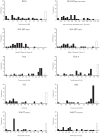Balance impairment in patients with moderate-to-severe traumatic brain injury: Which measures are appropriate for assessment?
- PMID: 35989909
- PMCID: PMC9381921
- DOI: 10.3389/fneur.2022.906697
Balance impairment in patients with moderate-to-severe traumatic brain injury: Which measures are appropriate for assessment?
Abstract
Left untreated, balance impairment following moderate-to-severe traumatic brain injury (TBI) can be highly debilitating and hinder activities of daily life. To detect impairments, clinicians need appropriate assessment tools. The objective of this study was to evaluate the feasibility and utility of a battery of clinical balance assessments in adults with moderate-to-severe TBI within 6-months of injury. Thirty-seven adults with TBI [Glasgow Coma Scale score ≤ 12 (33 M/4 F) age 18-50 years] participated in balance testing. Assessments included the Balance Error Scoring System (BESS), National Institutes of Health Standing Balance Test (NIH-SBT), Functional Gait Assessment (FGA), Advanced Functional Gait Assessment (FGA-A), Tandem Gait Test (TGT), Berg Balance Scale (BBS), and Walking While Talking Test (WWTT). We identified pronounced ceiling effects on the BBS and FGA, two widely used clinical balance assessments. The NIH-SBT, WWTT, and FGA used in conjunction with the FGA-A, offered versatility in their capacity to assess patients across the balance severity spectrum. This study provides evidence to support a stepwise approach to balance assessment that can be adapted to the broad range of balance ability found in moderate-to-severe TBI.
Keywords: balance; dual-task; gait; postural stability; traumatic brain injury.
Copyright © 2022 Joyce, Debert, Chevignard, Sorek, Katz-Leurer, Gagnon and Schneider.
Conflict of interest statement
The authors declare that the research was conducted in the absence of any commercial or financial relationships that could be construed as a potential conflict of interest.
Figures

Similar articles
-
Functional gait assessment and balance evaluation system test: reliability, validity, sensitivity, and specificity for identifying individuals with Parkinson disease who fall.Phys Ther. 2011 Jan;91(1):102-13. doi: 10.2522/ptj.20100113. Epub 2010 Nov 11. Phys Ther. 2011. PMID: 21071506 Free PMC article.
-
Construct and criterion validity of the functional gait assessment-Brazil in community-dwelling older adults.Braz J Phys Ther. 2021 Mar-Apr;25(2):186-193. doi: 10.1016/j.bjpt.2020.05.008. Epub 2020 Jun 9. Braz J Phys Ther. 2021. PMID: 32586617 Free PMC article.
-
Erratum.Mult Scler. 2016 Oct;22(12):NP9-NP11. doi: 10.1177/1352458515585718. Epub 2015 Jun 3. Mult Scler. 2016. PMID: 26041800
-
The community balance and mobility scale alleviates the ceiling effects observed in the currently used gait and balance assessments for the community-dwelling older adults.J Geriatr Phys Ther. 2015 Apr-Jun;38(2):78-89. doi: 10.1519/JPT.0000000000000024. J Geriatr Phys Ther. 2015. PMID: 24949849
-
The Functional Balance Ability Measure: A Measure of Balance Across the Spectrum of Functional Mobility in Persons Post-Stroke.Arch Rehabil Res Clin Transl. 2023 Sep 13;5(4):100296. doi: 10.1016/j.arrct.2023.100296. eCollection 2023 Dec. Arch Rehabil Res Clin Transl. 2023. PMID: 38163035 Free PMC article.
Cited by
-
Characteristics of the Functional Gait Assessment in adolescents with concussion.Neurosciences (Riyadh). 2023 Jul;28(3):165-169. doi: 10.17712/nsj.2023.3.20220140. Neurosciences (Riyadh). 2023. PMID: 37482380 Free PMC article.
References
LinkOut - more resources
Full Text Sources
Miscellaneous

